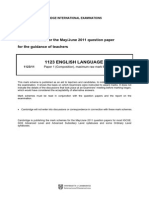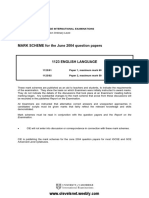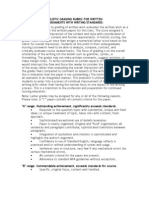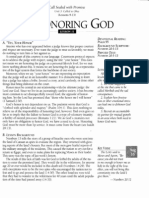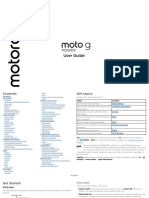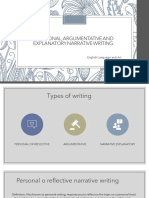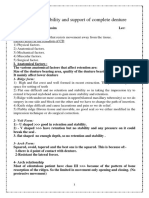IGCSE 中文201606 Mark-scheme Paper 21
IGCSE 中文201606 Mark-scheme Paper 21
Uploaded by
sschleungCopyright:
Available Formats
IGCSE 中文201606 Mark-scheme Paper 21
IGCSE 中文201606 Mark-scheme Paper 21
Uploaded by
sschleungCopyright
Available Formats
Share this document
Did you find this document useful?
Is this content inappropriate?
Copyright:
Available Formats
IGCSE 中文201606 Mark-scheme Paper 21
IGCSE 中文201606 Mark-scheme Paper 21
Uploaded by
sschleungCopyright:
Available Formats
Cambridge International Examinations
Cambridge International General Certificate of Secondary Education
FIRST LANGUAGE CHINESE 0509/21
Paper 2 Writing May/June 2016
MARK SCHEME
Maximum Mark: 40
Published
This mark scheme is published as an aid to teachers and candidates, to indicate the requirements of the
examination. It shows the basis on which Examiners were instructed to award marks. It does not indicate the
details of the discussions that took place at an Examiners’ meeting before marking began, which would have
considered the acceptability of alternative answers.
Mark schemes should be read in conjunction with the question paper and the Principal Examiner Report for
Teachers.
Cambridge will not enter into discussions about these mark schemes.
Cambridge is publishing the mark schemes for the May/June 2016 series for most Cambridge IGCSE®,
Cambridge International A and AS Level components and some Cambridge O Level components.
® IGCSE is the registered trademark of Cambridge International Examinations.
This document consists of 5 printed pages.
© UCLES 2016 [Turn over
Page 2 Mark Scheme Syllabus Paper
Cambridge IGCSE – May/June 2016 0509 21
Candidates will be awarded marks in two categories for the composition that they write:
• the first mark is out of 20 for Style and Accuracy: see Table A;
• the second mark is out of 20 for Content and Structure: see Table B1, B2 or B3 (depending on the
type of composition: Argumentative, Descriptive or Narrative).
TABLE A – STYLE AND ACCURACY
Band 1 18–20 • Fluent; variety of well-made sentences, including sophisticated complex
sentences where appropriate, used to achieve particular effects.
• Wide, consistently effective range of vocabulary with appropriately used
ambitious words.
• Assured use of grammar and punctuation, spelling accurate.
Band 2 15–17 • Mostly fluent; sentences correctly constructed, including a variety of complex
sentences.
• Vocabulary often effective, sometimes complex, mostly varied.
• Grammatically correct; punctuation mostly correct between and within
sentences; very occasional spelling mistakes.
Band 3 12–14 • Occasional fluency; sentences of some variety and complexity, correctly
constructed.
• Appropriate and accurate vocabulary with occasional examples of choice made
to communicate precise meaning or to give interest.
• Simple grammatical constructions correct; sentence separation mostly correct
but other forms of punctuation sometimes inconsistently used; occasional
spelling mistakes – but no error of any sort impedes communication.
Band 4 9–11 • Sentences tend to be simple and patterns repetitive. Where more complicated
structures are attempted there is lack of clarity and inaccuracy.
• Vocabulary communicates general meaning accurately.
• Some errors of punctuation including sentence separation; several spelling and
grammatical errors, rarely serious.
Band 5 6–8 • There may be the occasional grammatically complex sentence but mostly these
are simple and repetitively joined by ‘and’, ‘but’ and ‘so’, with other conjunctions
being used ineffectively, if at all.
• Vocabulary communicates simple details / facts accurately.
• Many errors of punctuation, grammar and spelling, but the overall meaning is
never in doubt.
Band 6 3–5 • Sentences are simple and sometimes faulty and / or rambling sentences
obscure meaning.
• Vocabulary is limited and may be inaccurate.
• Errors of punctuation, grammar and spelling may be serious enough to impede
meaning.
0, 1, 2 • Meaning of the writing is often lost because of poor control of language; errors
of punctuation, grammar and spelling too intrusive to award a mark in Band 6.
© Cambridge International Examinations 2016
Page 3 Mark Scheme Syllabus Paper
Cambridge IGCSE – May/June 2016 0509 21
TABLE B1 – ARGUMENTATIVE/DISCURSIVE TASKS
Band 1 18–20 • There is a consistent quality of well developed, logical stages in an overall, at
times complex, argument.
• Each stage is linked to and follows the preceding one. Sentences within
paragraphs are soundly sequenced.
Band 2 15–17 • Each stage of the argument is defined and developed, although the quality of
the explanation may not be consistent.
• The stages follow in a generally cohesive progression. Paragraphs are mostly
well sequenced, although some may finish less strongly than they begin.
Band 3 12–14 • There is a series of relevant points and a clear attempt is made to develop
some of them. These points are relevant, straightforward and logical / coherent.
• Repetition is avoided, but the order of the stages in the overall argument can be
changed without adverse effect. The sequence of the sentences within
paragraphs is satisfactory, although opportunities to link ideas may not be
taken.
Band 4 9–11 • Mainly relevant points are made and they are developed partially with some
effectiveness.
• The overall argument shows signs of structure but may be sounder at the
beginning than at the end. There may be some repetition. It is normally possible
to follow sequences of ideas, but there may be intrusive ideas or misleading
sentences.
Band 5 6–8 • A few relevant points are made and although they are expanded into
paragraphs, development is very simple and not always logical.
• Overall structure lacks a sense of sequencing. Paragraphs used only for
obvious divisions. It is sometimes possible to follow sequencing of sentences
within paragraphs.
Band 6 3–5 • A few points are discernible but any attempt to develop them is very limited.
• Overall argument only progresses here and there and the sequence of
sentences is poor.
0, 1, 2 • Rarely relevant, little material, and presented in a disorderly structure. Not
sufficient to be placed in Band 6.
© Cambridge International Examinations 2016
Page 4 Mark Scheme Syllabus Paper
Cambridge IGCSE – May/June 2016 0509 21
TABLE B2 – DESCRIPTIVE TASKS
Band 1 18–20 • There are many well defined, well developed ideas and images, describing
complex atmospheres with a range of details.
• Overall structure is provided through devices such as the movements of the
writer, the creation of a short time span, or the creation of atmosphere or
tension. Focus is description (not storytelling). Repetition is avoided and the
sequence of sentences makes the picture clear to the reader.
Band 2 15–17 • There is a good selection of interesting ideas and images, with a range of
details.
• These are formed into an overall picture of some clarity, largely consistent.
There may be occasional repetition and opportunities for development or the
provision of detail may be missed. Sentences are often well sequenced and the
description is often effective.
Band 3 12–14 • There is a selection of effective ideas and images that are relevant to the topic
and which satisfactorily address the task. An attempt is made to create
atmosphere and to provide some details.
• The description provides a series of points rather than a sense of their being
combined to make an overall picture, but some of the ideas are developed
successfully, albeit straightforwardly. Some sentences are well sequenced.
Band 4 9–11 • Some relevant and effective ideas are provided and occasionally developed a
little, perhaps as a narrative. There is some feeling of atmosphere, but most of
the writing is about events or description of objects or people.
• There is some overall structure, but the writing may lack direction and intent.
There may be interruptions in the sequence of sentences and / or some lack of
clarity.
Band 5 6–8 • Content is relevant but lacking in scope or variety. Opportunities to provide
development and detail are frequently missed.
• Overall structure, though readily discernible, lacks form and dimension. The
reliance on identifying events, objects and / or people sometimes leads to a
sequence of sentences without progression.
Band 6 3–5 • Some relevant facts are identified, but the overall picture is unclear and lacks
development.
• There are examples of sequenced sentences, but there is also repetition and
muddled ordering.
0, 1, 2 • Rarely relevant, little material and presented in a disorderly structure. Not
sufficient to be placed in Band 6.
© Cambridge International Examinations 2016
Page 5 Mark Scheme Syllabus Paper
Cambridge IGCSE – May/June 2016 0509 21
TABLE B3 – NARRATIVE TASKS
Band 1 18–20 • The narrative is complex and sophisticated and may contain devices such as
subtexts, flashbacks and time lapses. Cogent details are provided where
necessary or appropriate.
• The different sections of the story are carefully balanced and the climax
carefully managed. Sentence sequences are sometimes arranged to produce
effects such as the building up of tension or providing a sudden turn of events.
Band 2 15–17 • The writing develops some features that are of interest to a reader, although not
consistently so. Expect the use of detail and some build-up of character or
setting.
• The writing is orderly and the beginning and ending (where required) are
satisfactorily managed. The reader is aware of the climax even if it is not
managed completely effectively. The sequencing of sentences provides clarity
and engages the reader in events or atmosphere.
Band 3 12–14 • A straightforward story (or part of story) with satisfactory identification of
features such as character and setting.
• While opportunities for appropriate development of ideas are sometimes
missed, the overall structure is competent, and features of a developed
narrative are evident. Sentences are usually sequenced to narrate events.
Band 4 9–11 • A relevant response to the topic, but largely a series of events with occasional
details of character and setting.
• The overall structure is sound although there are examples where a particular
section is too long or too short. A climax is identified but is not effectively
described or led up to. Sentence sequences narrate events and occasionally
contain intrusive facts or misleading ideas.
Band 5 6–8 • A simple narrative with a beginning, middle and end (where appropriate). It may
consist of simple, everyday happenings or unlikely, un-engaging events.
• Unequal or inappropriate importance is given to the sections of the story.
Dialogue that has no function may be used or over-used. There is no real
climax. Sentence sequences are used only to link simple series of events.
Band 6 3–5 • Stories are very simple and narrate events indiscriminately. Endings are simple
and lack effect.
• The shape of the narrative is unclear; some of the content has no relevance to
the plot. Sequences of sentences are sometimes poor, leading to a lack of
clarity.
0, 1, 2 • Rarely relevant, little material, and presented in a disorderly structure. Not
sufficient to be placed in Band 6.
© Cambridge International Examinations 2016
You might also like
- Project Proposal Fro Equitable Access To Quality Education Through Installment of Publi WifiDocument2 pagesProject Proposal Fro Equitable Access To Quality Education Through Installment of Publi WifiSherwin Lomot92% (13)
- Blair ICBM Code ResponseDocument2 pagesBlair ICBM Code ResponseDan LamotheNo ratings yet
- Uses of Computer in NursingDocument3 pagesUses of Computer in NursingTami Selvi100% (5)
- Cambridge International Examinations Cambridge International General Certificate of Secondary EducationDocument5 pagesCambridge International Examinations Cambridge International General Certificate of Secondary Educationwalaa ahmadNo ratings yet
- IGCSE 中文 2015-paper-2-specimen-mark-schemeDocument6 pagesIGCSE 中文 2015-paper-2-specimen-mark-schemesschleungNo ratings yet
- 0508 First Language Arabic: MARK SCHEME For The October/November 2014 SeriesDocument5 pages0508 First Language Arabic: MARK SCHEME For The October/November 2014 SeriessCience 123No ratings yet
- 0508 First Language Arabic: MARK SCHEME For The October/November 2015 SeriesDocument5 pages0508 First Language Arabic: MARK SCHEME For The October/November 2015 SeriessCience 123No ratings yet
- 0508 First Language Arabic: MARK SCHEME For The May/June 2014 SeriesDocument5 pages0508 First Language Arabic: MARK SCHEME For The May/June 2014 SeriesAlaska DavisNo ratings yet
- 0508 First Language Arabic: MARK SCHEME For The May/June 2013 SeriesDocument5 pages0508 First Language Arabic: MARK SCHEME For The May/June 2013 SeriessCience 123No ratings yet
- 0508 First Language Arabic: MARK SCHEME For The October/November 2012 SeriesDocument5 pages0508 First Language Arabic: MARK SCHEME For The October/November 2012 SeriessCience 123No ratings yet
- Cambridge Assessment International Education: First Language Arabic 0508/02 October/November 2019Document6 pagesCambridge Assessment International Education: First Language Arabic 0508/02 October/November 2019walaa ahmadNo ratings yet
- 0508 First Language Arabic: MARK SCHEME For The October/November 2011 Question Paper For The Guidance of TeachersDocument5 pages0508 First Language Arabic: MARK SCHEME For The October/November 2011 Question Paper For The Guidance of Teacherswalaa ahmadNo ratings yet
- 0509 First Language Chinese: MARK SCHEME For The May/June 2011 Question Paper For The Guidance of TeachersDocument5 pages0509 First Language Chinese: MARK SCHEME For The May/June 2011 Question Paper For The Guidance of TeachersPenang Home TuitionNo ratings yet
- 3204 BENGALI: MARK SCHEME For The May/June 2015 SeriesDocument5 pages3204 BENGALI: MARK SCHEME For The May/June 2015 SeriesShadman ChowdhuryNo ratings yet
- Cambridge Assessment International Education: Setswana 3158/01 October/November 2018Document11 pagesCambridge Assessment International Education: Setswana 3158/01 October/November 2018ashleemakamure390No ratings yet
- November 2022 Mark Scheme Paper 01Document10 pagesNovember 2022 Mark Scheme Paper 01masegokeatweng3No ratings yet
- Cambridge O Level: Bengali 3204/01 May/June 2021Document7 pagesCambridge O Level: Bengali 3204/01 May/June 2021nayna sharminNo ratings yet
- Q OrbitalsDocument57 pagesQ OrbitalsBwit BwitNo ratings yet
- English Examinar ReportDocument11 pagesEnglish Examinar ReportSaadNo ratings yet
- Setswana Marking KeyDocument9 pagesSetswana Marking Keymemofaith10No ratings yet
- Pdf24 MergedDocument326 pagesPdf24 MergedSsuzie AnaNo ratings yet
- Cambridge Assessment International Education: Setswana 3158/01 October/November 2019Document10 pagesCambridge Assessment International Education: Setswana 3158/01 October/November 2019Segomotso MbaiwaNo ratings yet
- Cambridge Ordinary LevelDocument9 pagesCambridge Ordinary LevelSsuzie AnaNo ratings yet
- 3204 BENGALI: MARK SCHEME For The May/June 2008 Question PaperDocument5 pages3204 BENGALI: MARK SCHEME For The May/June 2008 Question Papermstudy123456No ratings yet
- 2018 Paper 1 Specimen Mark SchemeDocument10 pages2018 Paper 1 Specimen Mark SchemeAhmed HammadNo ratings yet
- Maximum Mark: 60: University of Cambridge International Examinations General Certificate of Education Ordinary LevelDocument8 pagesMaximum Mark: 60: University of Cambridge International Examinations General Certificate of Education Ordinary LevelRaja OwaisullahNo ratings yet
- 2017 2019 Specimen Paper 2 Mark SchemeDocument8 pages2017 2019 Specimen Paper 2 Mark SchemeAnitha NathenNo ratings yet
- Cambridge Assessment International Education: Bengali 3204/01 May/June 2019Document7 pagesCambridge Assessment International Education: Bengali 3204/01 May/June 2019Shadman ChowdhuryNo ratings yet
- Cambridge IGCSE™: Chinese As A Second Language 0523/03 May/June 2021Document6 pagesCambridge IGCSE™: Chinese As A Second Language 0523/03 May/June 2021For GamingNo ratings yet
- 0509 Y20 SM 2-EnglishDocument8 pages0509 Y20 SM 2-EnglishChanikan BuddeeNo ratings yet
- 1123 s14 Ms 11 PDFDocument9 pages1123 s14 Ms 11 PDFReem Amin Ul HaqNo ratings yet
- June 2020 Mark Scheme Paper 01Document7 pagesJune 2020 Mark Scheme Paper 01Md Jesmul HossainNo ratings yet
- 1123 w04 Ms 1Document7 pages1123 w04 Ms 1mstudy123456No ratings yet
- June 2011 Writing Paper A Marking SchemeDocument8 pagesJune 2011 Writing Paper A Marking SchemeMobarobberNo ratings yet
- Cambridge IGCSE™: First Language Malay 0696/02 May/June 2021Document9 pagesCambridge IGCSE™: First Language Malay 0696/02 May/June 2021HEMA MALAR A/P K RAMALINGAM MoeNo ratings yet
- 1123 English Language: MARK SCHEME For The October/November 2012 SeriesDocument8 pages1123 English Language: MARK SCHEME For The October/November 2012 SeriesSimona SingiorzanNo ratings yet
- Formal Writing yEAR 11-13Document33 pagesFormal Writing yEAR 11-13Labiba ZainNo ratings yet
- Cambridge IGCSE™: First Language French 0501/02 May/June 2022Document7 pagesCambridge IGCSE™: First Language French 0501/02 May/June 2022Angel MelendezNo ratings yet
- Cambridge IGCSE™ (9-1) : First Language Arabic 7184/02Document7 pagesCambridge IGCSE™ (9-1) : First Language Arabic 7184/02shabibibrahim808No ratings yet
- Cambridge Assessment International Education: First Language English (9-1) 0627/02 October/November 2017Document8 pagesCambridge Assessment International Education: First Language English (9-1) 0627/02 October/November 2017Shanmugam RajasinghamNo ratings yet
- MARK SCHEME For The November 2005 Question PaperDocument6 pagesMARK SCHEME For The November 2005 Question Papermstudy123456No ratings yet
- MARK SCHEME For The May/June 2006 Question Paper: University of Cambridge International Examinations GCE O LevelDocument7 pagesMARK SCHEME For The May/June 2006 Question Paper: University of Cambridge International Examinations GCE O Levelmstudy123456No ratings yet
- 1123 s04 Ms 12Document21 pages1123 s04 Ms 12Saad ArsalanNo ratings yet
- Cambridge Assessment International Education: English Language 9093/21 May/June 2019Document7 pagesCambridge Assessment International Education: English Language 9093/21 May/June 2019张查No ratings yet
- Cambridge O Level English Language 1123 - 22 Winter 2011 - Best Exam HelpDocument11 pagesCambridge O Level English Language 1123 - 22 Winter 2011 - Best Exam HelpMuhammad Talha Subhani50% (2)
- 0500 s10 Ms 22Document7 pages0500 s10 Ms 22Rana SidNo ratings yet
- Written Assessment RUBRICDocument2 pagesWritten Assessment RUBRICJoaquín MorenoNo ratings yet
- EDITED JIT EFAL P3 18 SEPTEMBER 2023-WordDocument95 pagesEDITED JIT EFAL P3 18 SEPTEMBER 2023-WordmlungisintulijnrNo ratings yet
- IGCSE 2nd Lang Engl Mark Scheme 2011 SummaryDocument3 pagesIGCSE 2nd Lang Engl Mark Scheme 2011 SummaryNathan CNo ratings yet
- MARK SCHEME For The November 2005 Question Paper: University of Cambridge International ExaminationsDocument2 pagesMARK SCHEME For The November 2005 Question Paper: University of Cambridge International ExaminationsAlihaNo ratings yet
- 0500 w05 Ms 3Document8 pages0500 w05 Ms 3Jay NandwaniNo ratings yet
- CW Grading RubricDocument6 pagesCW Grading RubricANDROID S.A.S OnlyNo ratings yet
- Argumentative Letter AnswerDocument10 pagesArgumentative Letter AnswerReema Sanaj100% (1)
- 8693 English Language: MARK SCHEME For The October/November 2009 Question Paper For The Guidance of TeachersDocument4 pages8693 English Language: MARK SCHEME For The October/November 2009 Question Paper For The Guidance of Teachersmstudy123456No ratings yet
- 8009 w11 Ms 1Document8 pages8009 w11 Ms 1Dani ShaNo ratings yet
- 2019 Pahang (Kuantan) English P1 & P2 AnswerDocument9 pages2019 Pahang (Kuantan) English P1 & P2 Answers geethaNo ratings yet
- Specimen Mark Scheme For Paper 1 For 2011Document12 pagesSpecimen Mark Scheme For Paper 1 For 2011Ростислав ПравденкоNo ratings yet
- 3204 BENGALI: MARK SCHEME For The May/June 2008 Question PaperDocument5 pages3204 BENGALI: MARK SCHEME For The May/June 2008 Question PaperafnanalzaidizaidiNo ratings yet
- June 2011 (v3) MSDocument8 pagesJune 2011 (v3) MSlaraibyunusabdulafeezNo ratings yet
- AP Spanish Literature and Culture 2016 Scoring Guidelines: © 2016 The College BoardDocument13 pagesAP Spanish Literature and Culture 2016 Scoring Guidelines: © 2016 The College BoardCervoise100% (1)
- Holistic Grading Rubric For Written AssignmentsDocument3 pagesHolistic Grading Rubric For Written Assignmentsrn4momsNo ratings yet
- NIV Lesson 08-16-2009 (Dishonoring God)Document8 pagesNIV Lesson 08-16-2009 (Dishonoring God)Shaun SweeneyNo ratings yet
- Decision Making PPTDocument36 pagesDecision Making PPTzainabNo ratings yet
- Ethics in Organization-The Case of Tata Steel: Presented by - Year) Rohit (MBA 1 Year)Document14 pagesEthics in Organization-The Case of Tata Steel: Presented by - Year) Rohit (MBA 1 Year)JayaNo ratings yet
- Pumps and Pumping StationsDocument10 pagesPumps and Pumping Stationskpostulart100% (2)
- ICSE2018 Rethink EE Architecture in Automotive To Facilitate Automation Connectivity and Electro Mobility 5Document11 pagesICSE2018 Rethink EE Architecture in Automotive To Facilitate Automation Connectivity and Electro Mobility 5Shivaji Bhausaheb ThoratNo ratings yet
- CIDB MyCESMM Library of Standard DescriptionsDocument173 pagesCIDB MyCESMM Library of Standard Descriptionskiet eelNo ratings yet
- Summer-2016 WJECDocument96 pagesSummer-2016 WJECDean MillarNo ratings yet
- 10 Influencer Marketing Email TemplatesDocument11 pages10 Influencer Marketing Email TemplatesMuhammad AnasNo ratings yet
- Moto G Power User GuideDocument40 pagesMoto G Power User GuideJex TerNo ratings yet
- B-B-Mental Toughness and Self-Confidence of Volleyball Extracurricular Participants A Study of Gender DifferencesDocument15 pagesB-B-Mental Toughness and Self-Confidence of Volleyball Extracurricular Participants A Study of Gender DifferencesAmry HartantoNo ratings yet
- GEMATMW Coding Theory NotesDocument8 pagesGEMATMW Coding Theory NotesRamil Joshua Trabado100% (1)
- PostmodernismDocument9 pagesPostmodernismAlan100% (1)
- Aft CraneDocument7 pagesAft CraneRobert KeithNo ratings yet
- Poweroof - Mono Quotation 5 KW 1PhDocument5 pagesPoweroof - Mono Quotation 5 KW 1PhShalinsha SolarizationNo ratings yet
- Deception in War and CamoflageDocument166 pagesDeception in War and Camoflageeventnow100% (4)
- Commands: Area Command Description And/or ExampleDocument4 pagesCommands: Area Command Description And/or Examplemanikanta100% (2)
- 7 Steps BOOK - 2015Document129 pages7 Steps BOOK - 2015NaixNo ratings yet
- Mcv4ub Unit2 Parul MarkedDocument21 pagesMcv4ub Unit2 Parul MarkedKaran RaghuvanshiNo ratings yet
- Chapter 08 - TDM, WDM, and CDM SystemsDocument58 pagesChapter 08 - TDM, WDM, and CDM SystemsSnehasis Hota100% (1)
- Powerpoint Presentation About Personal Argumentative and Explaanatory Narrative WritingDocument13 pagesPowerpoint Presentation About Personal Argumentative and Explaanatory Narrative Writingapi-549461032No ratings yet
- ™ Alt+0153 ← © ↔ ® £ ‰ Alt+0137 Per mille (per thousand) € ± $ ¼ ¢ ½ ¥ ¾ ƒ ≡ ₧ ≈ α ≥ ß ≤ δ √ Ω ⁿ ► ¹ ◄ ² ■ ³ ▲ π ▼ ° § ∞ ¶ µ " Σ " ☺ « ☻ » - ♥ ○ º ♂ œ ♀ - ↨ ↻ ↑ ↺ ↓ Ø → ÑDocument2 pages™ Alt+0153 ← © ↔ ® £ ‰ Alt+0137 Per mille (per thousand) € ± $ ¼ ¢ ½ ¥ ¾ ƒ ≡ ₧ ≈ α ≥ ß ≤ δ √ Ω ⁿ ► ¹ ◄ ² ■ ³ ▲ π ▼ ° § ∞ ¶ µ " Σ " ☺ « ☻ » - ♥ ○ º ♂ œ ♀ - ↨ ↻ ↑ ↺ ↓ Ø → ÑMonik kotadiaNo ratings yet
- Retention and Stability of Complete DentureDocument11 pagesRetention and Stability of Complete Dentureريام الموسويNo ratings yet
- Jump in B Teachers Book 2 - UnlockedDocument64 pagesJump in B Teachers Book 2 - UnlockedShei QuinterosNo ratings yet
- Saint Columban College: Item and Statitical Analysis of Computer 10 in Assessment in Learning 2Document6 pagesSaint Columban College: Item and Statitical Analysis of Computer 10 in Assessment in Learning 2Crystal Ann Monsale TadiamonNo ratings yet
- TESCO Casing Drive SystemDocument22 pagesTESCO Casing Drive SystemJohnSmith67% (3)
- Scientix MOOC 2022 LS TemplateDocument5 pagesScientix MOOC 2022 LS TemplatezdravkamajkicNo ratings yet

































